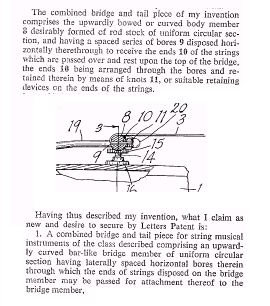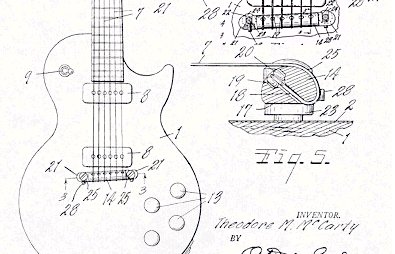|
Gibson Les Paul Historic 1954 Reissue Conversion to 1952 Reissue
Here's some info compiled from threads on various forums. Let me know what you think: ashbass@com.ashbass
. When you put an original '52 trapeze tailpiece on the R4 of course! I finally landed an original '52 tailpiece and set about getting it to work on my R4 as soon as it arrived. Victory is mine as I thought it might be. Here is the story. 
I always loved the look a '52 but the underwrap bridge put me off on looking into buying an R2. But the tailpiece was never the problem you see. The necks weren't pitched right on those early goldtops and that's why the bridges had to be underwrapped instead of topwrapped as was initially intended. But on a R4, which has the correct neck pitch angle, the trapeze bridge can do the topwrap it was designed for. 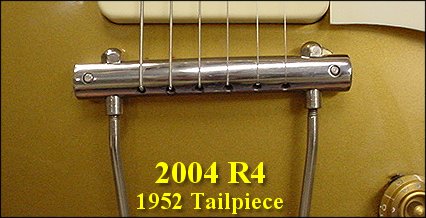
The '52 bridge posts floated on the face of the guitar, unlike the later guitars' posts which were anchored into the body. My bridge didn't come with the original feet/posts which was OK because I got the bridge cheaper without them and the R4 doesn't need them anyway. Besides, the forced height of those original posts and bases contributed to the too-highness of the bridge in the first place. My idea was to use the existing R4 posts as rests for the trapeze bridge bar. I cut off the top portion of two stud posts and sanded them smooth. 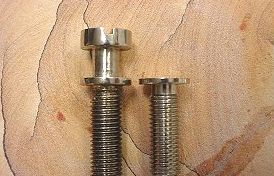
These new posts work like the thumbwheels on a Nashville style bridge in that they raise or lower the bridge by being screwed into or out of the body. In the photo below the bridge is way high to illustrate the concept. When set up for playing, the top disc of the post sits just above the body. 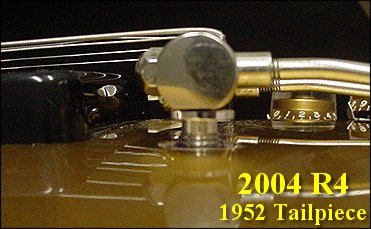
So now I have two guitars in one basically. If I get tired of the trapeze I can put the R4 stoptail back on and play that for a while. Then back to the trapeze when I want the '52 vibe. The only permanent change to the guitar are two small screw holes alongside the bottom strap button because the trapeze attaches with three screws down there (strap button screw and the two smaller ones). ~~~~~~~~~~~~~~~~~~~~~~~ Here's some further experimentation information. I got an ES style trapeze to try out on the R4 and ended up with this:
Another difference between the two is how the trapeze arm holes are aligned in the bridge bar. The goldtop bar has the bores for the arms going through perpendicular to the bar. The ES bar has the bores going through on a diagonal. The arm lengths are different as well with the goldtop arms the same length for both the bass and treble sides while the ES arms are shorter on bass side and longer on the treble side.
~~~~~~~~~~~~~~~~~~~~~~~ I found the patent for the bridge (2,737,842 - the number on the bottom of Gibson pickups for while) and checked it out. Below are three exerpts from the original trapeze patent that Les Paul submitted that detail his original invention and intention. The string channels were designed to be horizontal, not diagonal from the top to the bottom ala ES guitars, or diagonal from the bottom to the top ala the '52 Goldtop.
So Gibson at some time and for whatever reason, changed the specs on Les Paul's original design so the string bores could be diagonal. It is ironic that Ted McCarty's patent for the stop tailpiece (see below) called for a diagonal string bore (ala ES trapeze) and yet the production tailpiece, and all stop tailpieces thereafter, incorporated the horizontal bore as designed by Les.
==================== After some time the guitar started crackling when I'd play or rub any metal. This led to a large pain in the ass as I went through my pedal chain trying to locate the problem. Finally I came to the guitar and found out that where the bridge was contacting the treble sided bridge post (with the top cut off remember) there were areas of no contact and so no grounding for the bridge or strings. I could move the bridge just a tad over and I'd get grounding. Odd. I figure that since the post where I cut it was no longer coated in nickel, the exposed metal must have started to tarnish or something and this build up kept the bridge from fully connecting with the post, and thus the ground wire attached to the post. I thought of lightly sanding the post top, then of steel wooling it instead, but figured that the problem would just come back sooner or later. So, I bought a six inch long 1/8 drill bit and drilled a hole from just above the bottom strap button into the control cavity and ran a ground wire through it so it would contact the end of the trapeze where it attached to the guitar. The other end I soldered to the top of a pot inside the control cavity. Scary drilling, that was. The ground issue is now gone, and the guitar is now even more '52 than it was before. Weee! |


